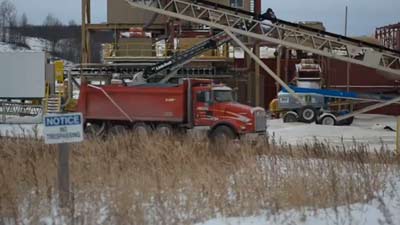 (Screengrab: Sand Land / DesmogBlog)The rush to drill for unconventional gas, enabled by a process popularly known as “fracking,” or hydraulic fracturing, has brought with it much collateral damage. Close observers know about contaminated water, earthquakes, and climate change impacts of the shale gas boom, but few look at the entire life cycle of fracking from cradle to grave.
(Screengrab: Sand Land / DesmogBlog)The rush to drill for unconventional gas, enabled by a process popularly known as “fracking,” or hydraulic fracturing, has brought with it much collateral damage. Close observers know about contaminated water, earthquakes, and climate change impacts of the shale gas boom, but few look at the entire life cycle of fracking from cradle to grave.
Until recently, one of the most underlooked facets of the industry was the “cradle” portion of the shale gas lifecycle: frac sand mining in the hills of northwestern Wisconsin and bordering eastern Minnesota, areas now serving as the epicenter of the frac sand mining world.
The silence on the issue ended after several good investigative stories were produced by outlets in the past year or so, such as Wisconsin Watch, PR Watch, The Wisconsin State Journal, the Associated Press, The Wall Street Journal, Orion, EcoWatch, and most recently, Tom Dispatch. These various articles, all well worth reading, explain the land grab currently unfolding in the Midwest and the ecological damage that has accompanied it.
To put it bluntly, there could be no shale gas extraction without the sand. As Tom Dispatch’s Ellen Cantarow recently explained,
That sand, which props open fractures in the shale, has to come from somewhere. Without it, the fracking industry would grind to a halt. So big multinational corporations are descending on this bucolic region to cart off its prehistoric sand, which will later be forcefully injected into the earth elsewhere across the country to produce more natural gas. Geology that has taken millions of years to form is now being transformed into part of a system, a machine, helping to drive global climate change.
Frac sand, which consists of fine-grained sillica, can cause the respiratory illness, silicosis. Washing the frac sand in preparation for the fracking process is also a water intensive process, particularly threatening in the age of increasing water scarcity in the United States and around the world.
“The state’s water supplies are also threatened as sand mining destroys sandstone formations which serve as giant filters for local aquifers.” Sara Jerving of PR Watch wrote. “The mining process can use thousands of gallons of water which can also deplete aquifers.”
The “frac sand rush” has been an uphill battle for small towns and municipalities that are trying to fight, or at the very least, attempt to negotiate with large corporations, with compartively little governmental oversight to deal with corporate behemoths such as EOG Resources, mirroring in many important ways the shale gas rush.
Cities and concerned citizens have done their best to keep up with the boom, but have no precedent to look for, no previous legislation to protect themselves, their infrastructure (see: roads and heavy trucks rolling through), their groundwater and their air.
Enter “Sand Land”
To further introduce the world to the impacts of frac sand mining, DeSmogBlog presents “Sand Land,” a short video report filmed and produced by Milwaukee, WI by photo-journalist and film-maker, Spencer Chumbley of 414 Wire, co-reported on with DeSmogBlog Research Fellow, Steve Horn. The film serves as a short audio-visual primer on the issue.
We encourage you to watch and share it with friends, colleagues, and family.
Stay tuned for much more to come from DeSmogBlog on one particularly powerful sand-mining corporation, EOG Resources, formerly known as the now infamous Enron Oil and Gas, a little explored fossil fuel industry giant that does it all: frac sand mining, fracking, pipelines, and LNG terminals.
Thank you for reading Truthout. Before you leave, we must appeal for your support.
Truthout is unlike most news publications; we’re nonprofit, independent, and free of corporate funding. Because of this, we can publish the boldly honest journalism you see from us – stories about and by grassroots activists, reports from the frontlines of social movements, and unapologetic critiques of the systemic forces that shape all of our lives.
Monied interests prevent other publications from confronting the worst injustices in our world. But Truthout remains a haven for transformative journalism in pursuit of justice.
We simply cannot do this without support from our readers. At this time, we’re appealing to add 30 monthly donors before the end of the day. If you can, please make a tax-deductible one-time or monthly gift today.